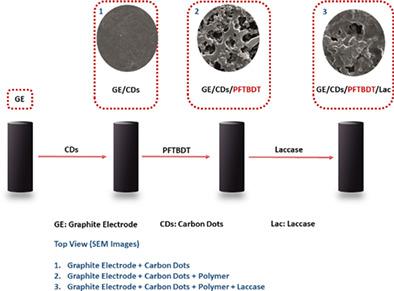当前位置:
X-MOL 学术
›
J. Polym. Sci.
›
论文详情
Our official English website, www.x-mol.net, welcomes your
feedback! (Note: you will need to create a separate account there.)
Construction of amperometric biosensor modified with conducting polymer/carbon dots for the analysis of catechol
Journal of Polymer Science ( IF 3.9 ) Pub Date : 2020-10-21 , DOI: 10.1002/pol.20200647 Mustafa Yasa 1 , Aybuke Deniz 2 , Mehrdad Forough 2 , Erol Yildirim 1, 2 , Ozgul Persil Cetinkol 2 , Yasemin Arslan Udum 3 , Levent Toppare 1, 2, 4, 5
Journal of Polymer Science ( IF 3.9 ) Pub Date : 2020-10-21 , DOI: 10.1002/pol.20200647 Mustafa Yasa 1 , Aybuke Deniz 2 , Mehrdad Forough 2 , Erol Yildirim 1, 2 , Ozgul Persil Cetinkol 2 , Yasemin Arslan Udum 3 , Levent Toppare 1, 2, 4, 5
Affiliation

|
Phenolic compounds used in food industries and pesticide industry, are environmentally toxic and pollute the rivers and ground water. For that reason, detection of phenolic compounds such as catechol by using simple, efficient and cost‐effective devices have been becoming increasingly popular. In this study, a suitable and a novel matrix was composed using a novel conjugated polymer, namely poly[1‐(5‐(4,8‐bis(5‐(2‐ethylhexyl)thiophen‐2‐yl)benzo[1,2‐b:4,5‐b']dithiophen‐2‐yl)furan‐2‐yl)‐5‐(2‐ethylhexyl)‐3‐(furan‐2‐yl)‐4H thieno[3,4‐c]pyrrole‐4,6(5H)‐dione] (PFTBDT) and carbon dots (CDs) to detect catechol. PFTBDT and CDs were synthesized and the optoelectronic properties of PFTBDT were investigated via electrochemical and spectroelectrochemical studies. Laccase enzyme was immobilized onto the constructed film matrix on the graphite electrode. The proposed biosensor was found to have a low detection limit (1.23 μM) and a high sensitivity (737.44 μA/mM.cm−2) with a linear range of 1.25–175 μM. Finally, the applicability of the proposed enzymatic biosensor was evaluated in a tap water sample and a satisfactory recovery (96–104%) was obtained for catechol determination.
中文翻译:

导电聚合物/碳点修饰的电流型生物传感器的构建,用于儿茶酚的分析
食品工业和农药工业中使用的酚类化合物具有环境毒性,并污染河流和地下水。因此,使用简单,高效和具有成本效益的设备检测邻苯二酚等酚类化合物已变得越来越普遍。在这项研究中,使用新型共轭聚合物,即聚[1-(5-(4,8-双(5-(2-乙基己基)噻吩-2-基)苯并[1, 2‐b:4,5‐b']二噻吩‐2‐基)呋喃‐‐2‐基)‐‐‐‐‐‐‐‐‐‐‐‐‐‐‐ phen ‐‐‐‐‐‐‐‐‐‐‐ [‐‐‐‐‐‐‐‐‐‐‐‐‐‐‐‐‐‐‐‐‐‐‐‐‐‐‐‐‐‐ [‐‐‐‐‐‐‐‐‐‐ 3H‐3H‐噻吩[3,4‐c [吡咯-4,6(5H)-二酮](PFTBDT)和碳点(CD)检测邻苯二酚。合成了PFTBDT和CD,并通过电化学和光谱电化学研究了PFTBDT的光电性能。将漆酶固定在石墨电极上构建的膜基质上。−2)的线性范围为1.25–175μM。最后,在自来水样品中评估了所提出的酶促生物传感器的适用性,儿茶酚的测定回收率令人满意(96-104%)。
更新日期:2020-12-02
中文翻译:

导电聚合物/碳点修饰的电流型生物传感器的构建,用于儿茶酚的分析
食品工业和农药工业中使用的酚类化合物具有环境毒性,并污染河流和地下水。因此,使用简单,高效和具有成本效益的设备检测邻苯二酚等酚类化合物已变得越来越普遍。在这项研究中,使用新型共轭聚合物,即聚[1-(5-(4,8-双(5-(2-乙基己基)噻吩-2-基)苯并[1, 2‐b:4,5‐b']二噻吩‐2‐基)呋喃‐‐2‐基)‐‐‐‐‐‐‐‐‐‐‐‐‐‐‐ phen ‐‐‐‐‐‐‐‐‐‐‐ [‐‐‐‐‐‐‐‐‐‐‐‐‐‐‐‐‐‐‐‐‐‐‐‐‐‐‐‐‐‐ [‐‐‐‐‐‐‐‐‐‐ 3H‐3H‐噻吩[3,4‐c [吡咯-4,6(5H)-二酮](PFTBDT)和碳点(CD)检测邻苯二酚。合成了PFTBDT和CD,并通过电化学和光谱电化学研究了PFTBDT的光电性能。将漆酶固定在石墨电极上构建的膜基质上。−2)的线性范围为1.25–175μM。最后,在自来水样品中评估了所提出的酶促生物传感器的适用性,儿茶酚的测定回收率令人满意(96-104%)。











































 京公网安备 11010802027423号
京公网安备 11010802027423号